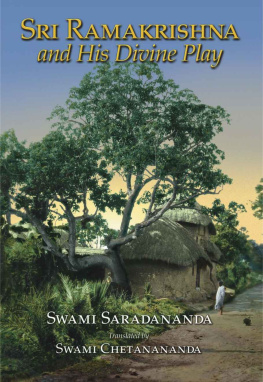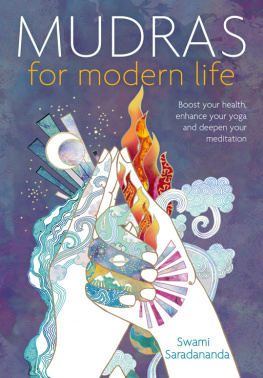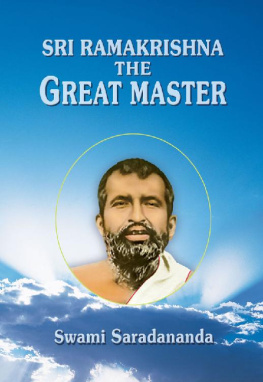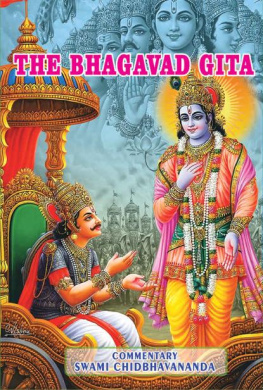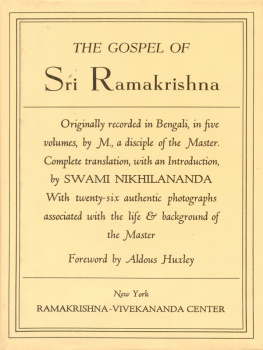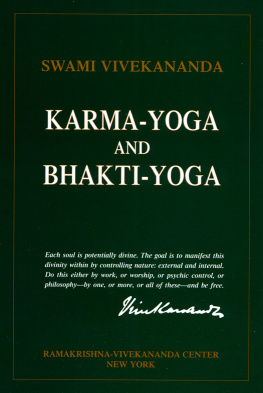Swami Saradananda - Sri Ramakrishna and His Divine Play
Here you can read online Swami Saradananda - Sri Ramakrishna and His Divine Play full text of the book (entire story) in english for free. Download pdf and epub, get meaning, cover and reviews about this ebook. year: 2018, publisher: Vedanta Society of St. Louis, genre: Religion. Description of the work, (preface) as well as reviews are available. Best literature library LitArk.com created for fans of good reading and offers a wide selection of genres:
Romance novel
Science fiction
Adventure
Detective
Science
History
Home and family
Prose
Art
Politics
Computer
Non-fiction
Religion
Business
Children
Humor
Choose a favorite category and find really read worthwhile books. Enjoy immersion in the world of imagination, feel the emotions of the characters or learn something new for yourself, make an fascinating discovery.
- Book:Sri Ramakrishna and His Divine Play
- Author:
- Publisher:Vedanta Society of St. Louis
- Genre:
- Year:2018
- Rating:4 / 5
- Favourites:Add to favourites
- Your mark:
- 80
- 1
- 2
- 3
- 4
- 5
Sri Ramakrishna and His Divine Play: summary, description and annotation
We offer to read an annotation, description, summary or preface (depends on what the author of the book "Sri Ramakrishna and His Divine Play" wrote himself). If you haven't found the necessary information about the book — write in the comments, we will try to find it.
Sri Ramakrishna and His Divine Play — read online for free the complete book (whole text) full work
Below is the text of the book, divided by pages. System saving the place of the last page read, allows you to conveniently read the book "Sri Ramakrishna and His Divine Play" online for free, without having to search again every time where you left off. Put a bookmark, and you can go to the page where you finished reading at any time.
Font size:
Interval:
Bookmark:


Swami Saradananda
a direct disciple of Sri Ramakrishna
Swami Chetanananda
Vedanta Society of St. Louis
Copyright 2003 Vedanta Society of St. Louis
All rights reserved. No part of this book may be used or reproduced in any manner whatsoever without permission in writing from the publisher, with the sole exception of brief quotations embodied in critical articles or reviews.
978-0-916356-08-8 (ebook)
Library of Congress Cataloging-in-Publication Data
Saradananda, Swami, 18651927.
[Sri Sri Rmakrsna Lilprasanga. English.]
Sri Ramakrishna and his divine play / Swami Saradananda, Swami Chetanananda.1st ed.
p. cm.
Includes .
In English translated from Bengali.
ISBN 0-916356-81-7 (hard)
1. Ramakrishna, 18361886. 2. Ramakrishna Mission Biography. 3. Hindus India Biography. I. Chetanananda, Swami. II. Title.
BL1280.292.R36S266 2003
294.555092dc22
2003021062
FIRST EDITION 2003
Second Printing 2006
Cover design by Diane Marshall
Those who wish to learn in greater detail about the teachings contained in this book may write to:
Vedanta Society of St. Louis
205 S. Skinker Blvd.
St. Louis, MO 63105, U.S.A.
www.vedantastl.org
Sri Ramakrishna and His Divine Play is a new translation of Sri Sri Ramakrishna Lilaprasanga, which was written in Bengali by Swami Saradananda, a monastic disciple of Sri Ramakrishna. This is the authentic, factual, descriptive, interpretive, and comprehensive biography of Sri Ramakrishna, the spiritual phenomenon of our age.
Sri Ramakrishna was born on 18 February 1836 and passed away on 16 August 1886. He enacted his divine play in three parts. First, he spent his early life (1836 to 1852) in the rural atmosphere of his native village, Kamarpukur. Second, he spent his adult life (1852 to 1885) in Calcutta and nearby Dakshineswar. He stayed in Calcutta with his brother for a couple of years, and then moved to the temple garden of Dakshineswar, where he lived for the next thirty years. It was in Dakshineswar that he practised various sadhanas, attained illumination, and began to promulgate his divine mission. Third, he spent the last year of his life (September 1885 to August 1886) in Calcutta and in the Cossipore garden house, where he brought his divine drama to its close by forming the future Ramakrishna Order.
Swami Saradananda wrote his magnum opus in five volumes, beginning with . He explained why he did not follow a chronological sequence as he worked: Unless people understand how the Master remained in bhavamukha (an exalted state between the Absolute and the Relative) and how the mood of a guru was natural to him, they will not be able to comprehend the Masters wonderful character, unprecedented mental state, and extraordinary activities. That is why we tried to make the reader understand this subject at the outset. He published serially some parts of Lilaprasanga in the magazine Udbodhan, beginning in 1909 and continuing until 1919. He later said that it was because he was not inspired from within that he did not complete the last part of the Masters life with details about the daily events in Cossipore and an account of the Masters death.
It is amazing that Swami Saradananda was able to collect all of the important details about the Masters life even though he started writing this biography twenty-three years after the Master passed away. I have had the privilege of seeing the notebook in which he jotted down brief descriptions of incidents : When we first started writing about the Masters divine play, we never imagined that we would proceed so far. It was possible only by his inconceivable grace. This detailed biography of Sri Ramakrishna is unique in spiritual literature; we can find no similar detailed accounts for Krishna, Buddha, or Christ.
The swami wrote in his preface to the : The Master told us explicitly again and again: He who was born as Rama and as Krishna in previous ages is now in this sheath (as he pointed to his own body). The spiritual experiences of this place (meaning himself) have surpassed even the Vedas and Vedanta. While recounting as impartially as possible the biography of Sri Ramakrishna, who was established in bhavamukha, we were forced to admit that such an extraordinary life had never before been seen in the spiritual world.
I humbly ask the reader to approach this book with an open mind. Sri Ramakrishna experimented with and verified the Truth, or God, like a scientist. He never taught anything that he had not experienced himself. Later, when Swami Vivekananda asked the Master, Sir, have you seen God? he replied without a moments hesitation: Yes, I have seen God. I see Him as I see you here, only more clearly. God can be seen. One can talk to Him. Thus, Sri Ramakrishna met the challenges raised by some of his English-educated disciples and dispelled their doubts. Even agnostics and atheists were dumbfounded when they saw the Master in samadhi. He never said anything that was contrary to reason, and he always encouraged his disciples to test his words before accepting them. His life is a glowing beacon in an age that is trying to recover its bearings in a turbulent sea of opinions about religion.
In addition to an account of the god-intoxicated life of Sri Ramakrishna, the reader will find in this book glimpses of mysticism, discussions of various religious and philosophical traditions of India, accounts of different religious leaders, and descriptions of the social customs, the educational system, and the socio-religious movements of nineteenth-century India. It is really astounding how Sri Ramakrishna, who had no formal education, overwhelmed the great savants and religious leaders of India with his spiritual power. In this book the reader will see how Sri Ramakrishna, the avatar of our modern age, lived and behaved, how he practised sadhana and taught spirituality, how he evaluated and trained his disciples by observing their physical characteristics and reading their minds as one would a book, how he used parables and folktales in his teachings, how he laughed and cried, sang and danced, made jokes like an ordinary human being, and at the same time frequently experienced spiritual visions and samadhi. It is important to see how Sri Ramakrishnas divine life reflected his phenomenal renunciation, passion for truth, childlike simplicity, complete lack of egotism, longing for God, and love for humanity.
This book bears witness to Sri Ramakrishnas testimony that all religions are equally valid. He found a place for each one in his own life. He first realized God by following Hindu practices, and then by following the Christian and Muslim paths. Such a journey is unique in the religious history of the world. He afterwards proclaimed, As many faiths, so many paths, thus establishing an ideal harmony of religions for our present age, in which religions are in conflict and hatred and violence are rampant. He taught a religion so badly needed today, a religion that is constructive and not destructive, scientific and not fanatical, practical and not theoretical, rational and not superstitious, universal and not parochial. Truly, Sri Ramakrishna worked to create unity in our time and he repeatedly stated that the goal of human life is to realize God.
Font size:
Interval:
Bookmark:
Similar books «Sri Ramakrishna and His Divine Play»
Look at similar books to Sri Ramakrishna and His Divine Play. We have selected literature similar in name and meaning in the hope of providing readers with more options to find new, interesting, not yet read works.
Discussion, reviews of the book Sri Ramakrishna and His Divine Play and just readers' own opinions. Leave your comments, write what you think about the work, its meaning or the main characters. Specify what exactly you liked and what you didn't like, and why you think so.

